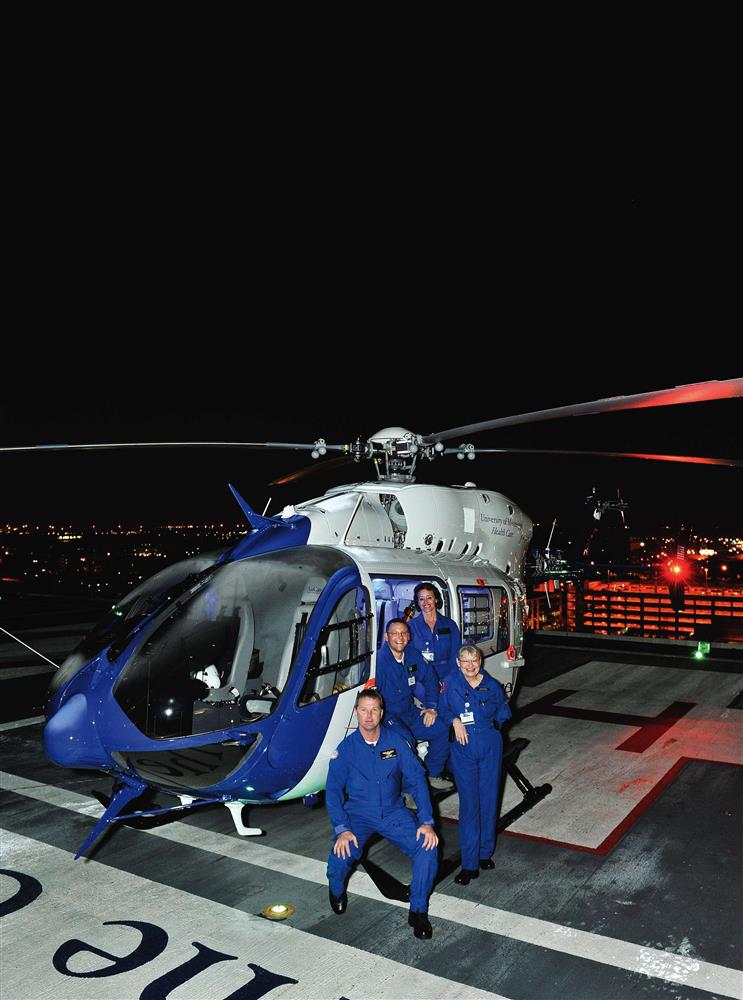UMMC's original aircare crew celebrates 15 years of service

AirCare, University of Mississippi Medical Center's helicopter transport service, turned 15 this month.
In 15 years, the AirCare crew has flown more than 1.7 million miles and transported more than 13,000 patients with a perfect safety record. The first AirCare helicopter made its maiden flight on Feb. 2, 1996.
Four members of the original AirCare crew are still on the job. They know each other better than they know members of their own families. They depend on each other on flights that can take them to both ends of the state during almost any kind of weather carrying and caring for a critically ill patient.
"It's a brother-sister thing," says Bo Sullivan, flight nurse.
"Or a mama-son thing," replies Jamie Miller, newborn transport nurse.
They've been together on so many flights, they've lost count.
"We were young when we all started," says Cathy Delaney, newborn transport nurse. "Now all of us have to have reading glasses."
"I used to jump off the helicopter. Now I sit on the edge and climb down," says Miller.
"Reading glasses have become part of your essential gear," says flight nurse and paramedic Todd Perry.
This foursome is part of a crew that includes 11 RNs, 12 paramedics, eight pilots and four mechanics. One helicopter (the newest) is based here; a second, based in Meridian, was added in 2009.
The two choppers are the only emergency helicopters in the state that are instrument rated, meaning they can fly in almost any weather except dense fog, tornadic winds and ice.
Perry is an aviation enthusiast and has a fixed- wing license. The Medical Center's original helicopter, LifeStar, (in service from 1983 through 1990) picked up his father when he sustained a head injury.
"I was a child, but I remember asking someone what you would have to do to get a job on a helicopter," he said. "I've always wanted to fly."
Delaney, on the other hand, almost quit her job in newborn transport when she got her orders to be part of the helicopter service.
"I was terrified. I was hyperventilating during the first trip to pick up a patient."
She had been a nurse in the newborn intensive care unit and joined the ground ambulance newborn transport team in 1993. Three years later, she was a reluctant member of the AirCare crew.
She got over her fear. Now she says she loves every minute of it. "I just developed a lot of camaraderie with my fellow crew members...and the pilots. My life is in their hands, and I trust them."
The nurses and paramedics may be the people the patients remember most vividly, but after all, air transport would not exist without specially trained helicopter pilots. And they do more than just fly.
"The pilots will get dirty with you," says Perry. "After they land the copter at a hospital, they're right there with us with the patient, holding bags, handing us gear, holding lights. They're a wealth of help."
Sullivan, a lieutenant colonel in the Air National Guard, describes his colleagues and himself as "type A" personality types - focused, driven and having the ability to "adapt, adjust and improvise."
"You never know what you'll find at the destination," he said. "Often it's not what you expected at all-like going after a baby and having to resuscitate an adult as well."
"We all have a little McGyver in us," said Perry, referring to the popular television character who evades death and catastrophe with a Swiss army knife and duct tape. Miller is especially adept at repairing malfunctioning machines in the air.
"We don't fly with a mechanic, and I'm pretty good with tools."
This high-intensity, adrenaline-pumping job isn't for everyone, but it's not without its rewards.
"There's just nothing like knowing you had something to do with saving a person's life," Delaney said.
And the blue jump suits, regulation attire for the crew, are becoming very well recognized around the state. The excitement generated by an AirCare landing in a rural community makes the crew minor celebrities.
"I think we've become pretty good ambassadors for the University," said Perry.
The crew gets a lot of positive reinforcement from the reactions of the hospital staff and ground crews when they arrive.
"It's usually, 'Thank God you're here,' " Perry said.
Miller said one nurse in a rural hospital, relieved that her patient was leaving in the hands of newborn specialists, told her, "I like your front, but I like your behind a lot better."
Donna Norris, chief flight nurse and director of AirCare, expects and gets the best from her crew. She's been with AirCare since 1997, and now she's the department head, rarely getting the opportunity to go up now. "I do miss that," she said.
Being a comfort and help to people in dire need is what drives most emergency responders, including flight crews.
"I held a man's hand and talked with him all the way back from south Mississippi on one flight," Norris said. "He had a horrific facial injury and was terrified. When you get to help people in situations like that, there's no higher job satisfaction."


